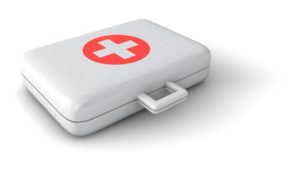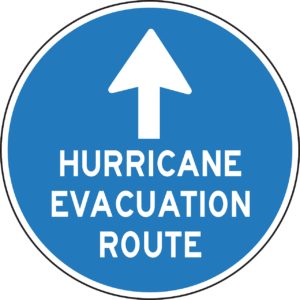Eight Things to Include in Your Pet Disaster Preparedness Plan

With Hurricane Florence wreaking havoc on the Carolinas, it seems like the perfect time to consider how our pets fit into our emergency plans. Personally, the only thing that stresses me out more than preparing for a natural disaster is thinking about how my five-pound ball of fluff is going to take it.
So how can you create an disaster preparedness plan for your pets? Here are 8 tips to make sure your pet is emergency ready!
1. Use Common Sense
First and foremost, if it’s too dangerous for us to be there, it’s too dangerous for our pet to be there. Having a plan to ensure our pets safety is as imperative as having a plan for our safety.
 2. Neighborhood Buddy System
2. Neighborhood Buddy System
You may not be home when disaster strikes, so it’s important to have a plan for what to do if you aren’t there. Find a neighbor whom you can trust that’s home when you’re working. You want them to be around when you’re out and you need to be able to trust them with a key to your house and the care of your pets.
Make sure they know where your emergency kit is, your pet’s feeding schedule and any medical needs. You’ll also want to discuss important details such as how long you might need your neighbor to watch your pet, and what your neighbor’s plan would be in an emergency. Knowing all expectations is essential to avoid any confusion during the craze and the stress of natural disasters.
3. Making Your Home Safe
When the first warnings of disaster strikes bring all animals inside, they can spook easily during these times and end up lost. Find the safest rooms in your house for you and your pets. You want this area to be somewhere that’s easy to clean and has access to fresh water. Close off any unsafe nooks or crannies, and secure dangerous tools and toxic materials. If you find yourself in an electric outage or amidst some other utility issue, consider filling a bathtub or sink with water. For advice specific to your region try calling your local shelter to find out what precautions they are taking.
4. Identification
In addition to having your pet microchipped and ensuring they have a collar with ID tags on, one of the most interesting bits of advice I’ve seen going around on Facebook is to use a sharpie to write your pet’s name and your phone number on their stomach. This way if you get separated from them and they get out of their collar or someone finds them but doesn’t have a microchip reader, they can find your information already written on your pet! How smart is that?
5. Evacuation
Reach out to the local disaster shelters to see if they accept pets. A lot of them don’t due to health concerns. Those planning to stay with a friend or family member living in a safe area outside the evacuation zone, it’s essential to find out if they can house your pets as well. It’s possible you will have to split your pets up to ensure they are all accommodated. If you plan to stay in a hotel or motel, find out about their pet policy ahead of time.
 Not to worry if you don’t have a housing situation for you and your pets, make sure you check out the animal kennels in the areas you plan to stay. Check availability and if need be reserve a spot as early as possible. You’ll also want to check out the local vet and pet hospitals, though let’s hope you won’t ever have to use that information.
Not to worry if you don’t have a housing situation for you and your pets, make sure you check out the animal kennels in the areas you plan to stay. Check availability and if need be reserve a spot as early as possible. You’ll also want to check out the local vet and pet hospitals, though let’s hope you won’t ever have to use that information.
Have your emergency kit packed in a secure box that’s easily accessible and ready to go.
6. Recommended Health Precautions by the CDC
When disaster strikes health risks increase, so it’s vital that we take extra precautions during these times to keep you and your pets healthy. First of all, wash your hands—it’s the obvious advice, but also the most important. From there make sure you’re handling your pet with extra care. Disasters are scary for everyone, and our pets are particularly likely to be spooked during this time. They need our gentle care, and if we touch them it should be soothing, otherwise, try to keep them in their cages or crates, so they don’t wander off.
7. After Disaster
Keep your pet in their cage or carrier inside your house while you find out the extent of the damage. Don’t let them back outside till you’ve confirmed your area is safe and secure. Check for wild animals inside and outside of your house, particularly in the case of flooding. Remember they can be unusually erratic after a disaster, so you don’t want your pets interacting with them. Your pets may still be unsettled as well so take some time to comfort them and make sure they feel comfortable.
8. Emergency Kit
So what about an emergency kit? You probably have one for yourself, but your pets need one too! Here are some good rules of the road to follow with pet emergency kits.
All Pets
- A week’s worth of food.
- Be sure to replace regularly, based on the expiration dates of the food. A great way to maintain fresh pet food is to order double once and then exchange the old emergency food in your kit with the new food. Then use that old food to feed your pet.
 A week’s worth of medication
A week’s worth of medication
- Again be sure to replace regularly based off of the expiration dates.
- Up to date identification tags.
- The CDC recommends getting your pet chipped. Of course, there’s always the moral conundrum of whether it’s right for us to choose for our pets to have this type of elective surgery. To avoid the debate all together, there are a number of pet GPS tags that are unobtrusive and perfectly effective.
- Disposable garbage bags
- Pet feeding dishes
- A week’s worth of water
- Recent photo of your pet in case they get spooked and lost
- Medical documents, including but not limited to vaccinations and medical conditions
- First aid kit
- Familiar items for your pet’s comfort
Dogs
- 2x Leash
- Toys/chew toys
- Pee pads
- Crate or carrier
Cats
Birds
- Cage or travel carrier
- Blanket to cover the cage
- Spray bottle to cool bird in heat
- Line cage with paper towels
- Keep in a quiet place
- Timed feeder to ensure a bird is fed regularly in case you are unable to get home for an extended period
Reptiles
- Sturdy bowl for the pet to soak in
- Pillowcase okay for transport but need housing for reptile
- Heat source even if it’s just a heating pad or hot water bottle
Small Animals
- Secure carriers that can hold their bedding material, food, and water
- Extra water bottle, a weeks worth of bedding and a little hide box

